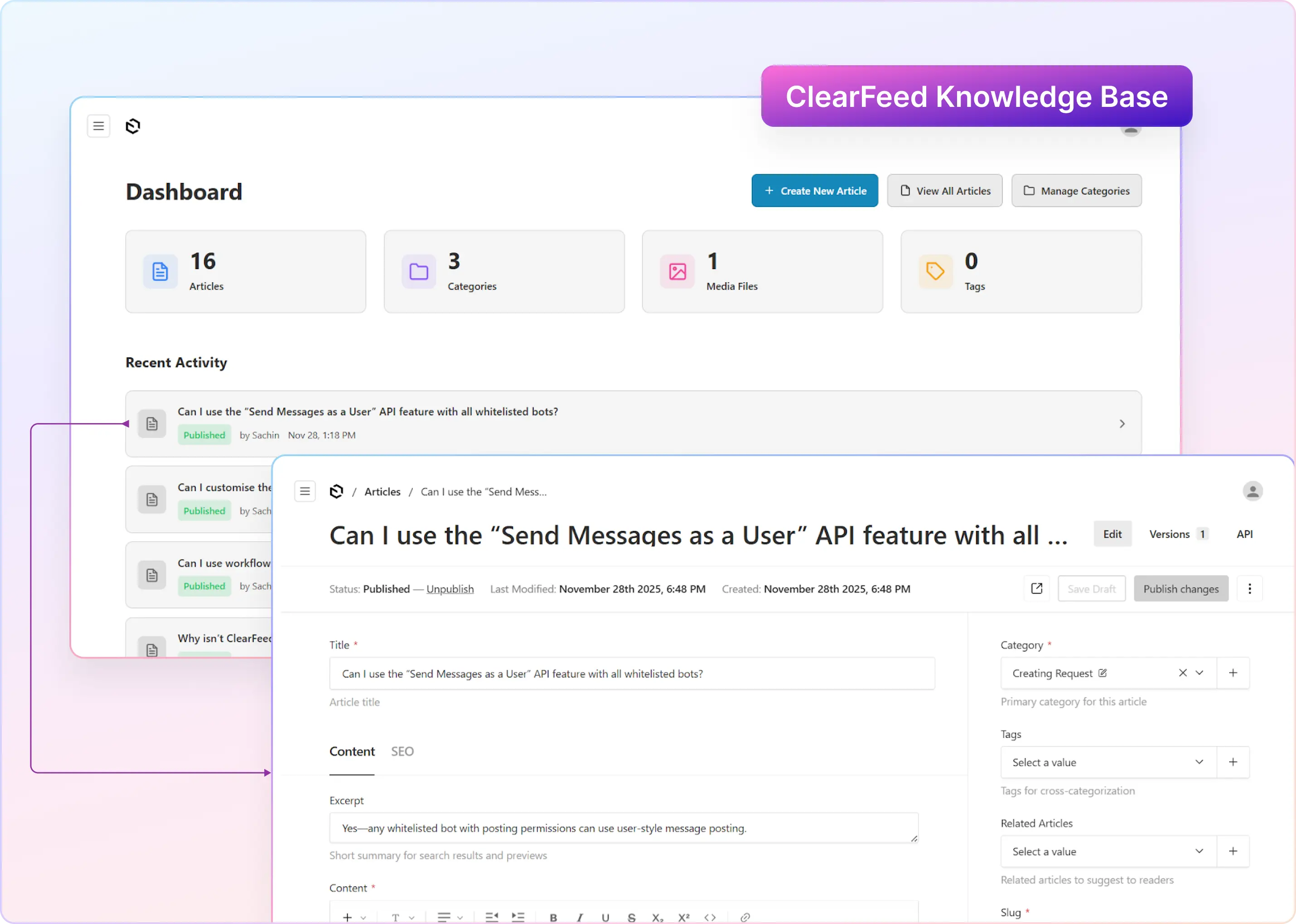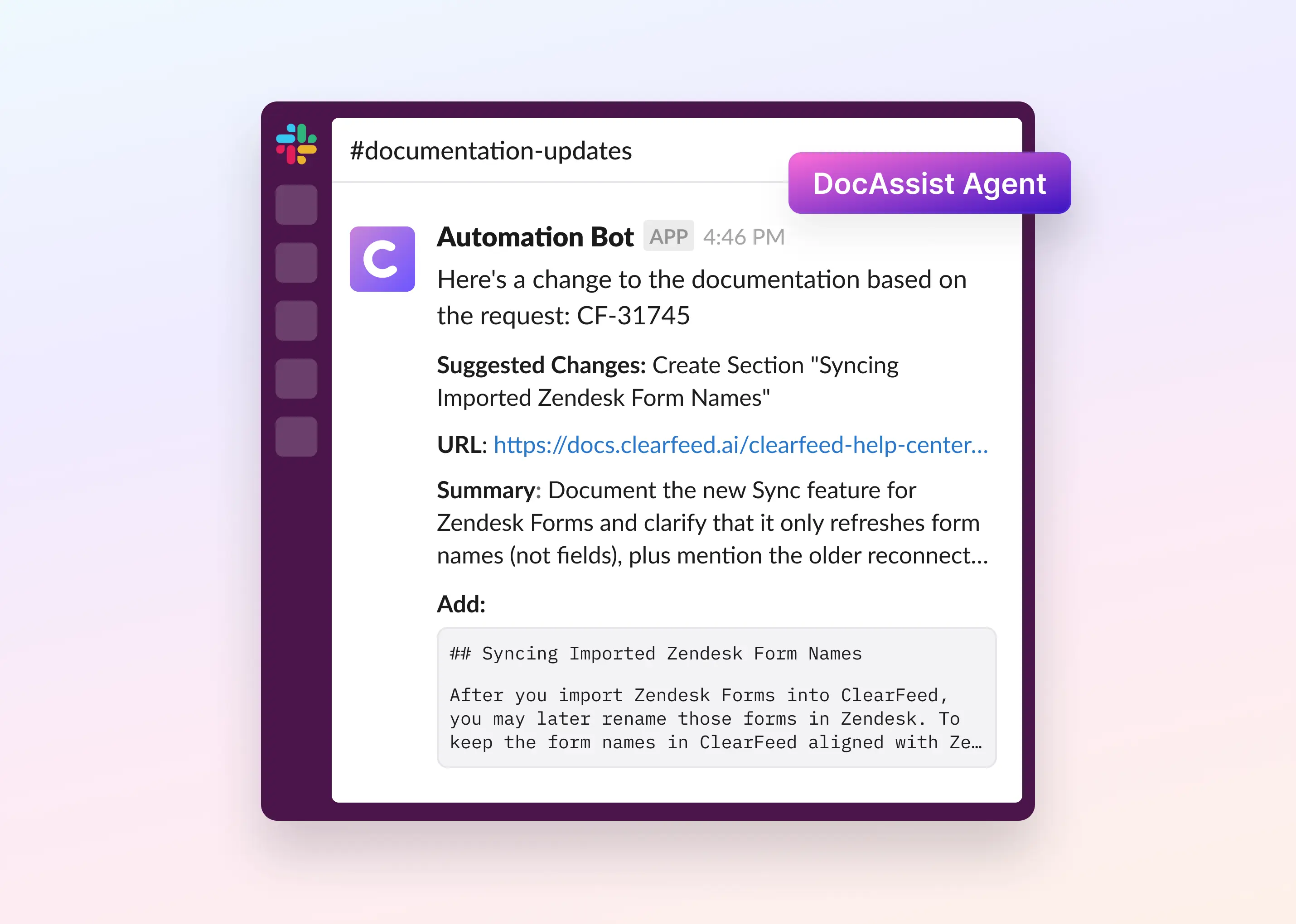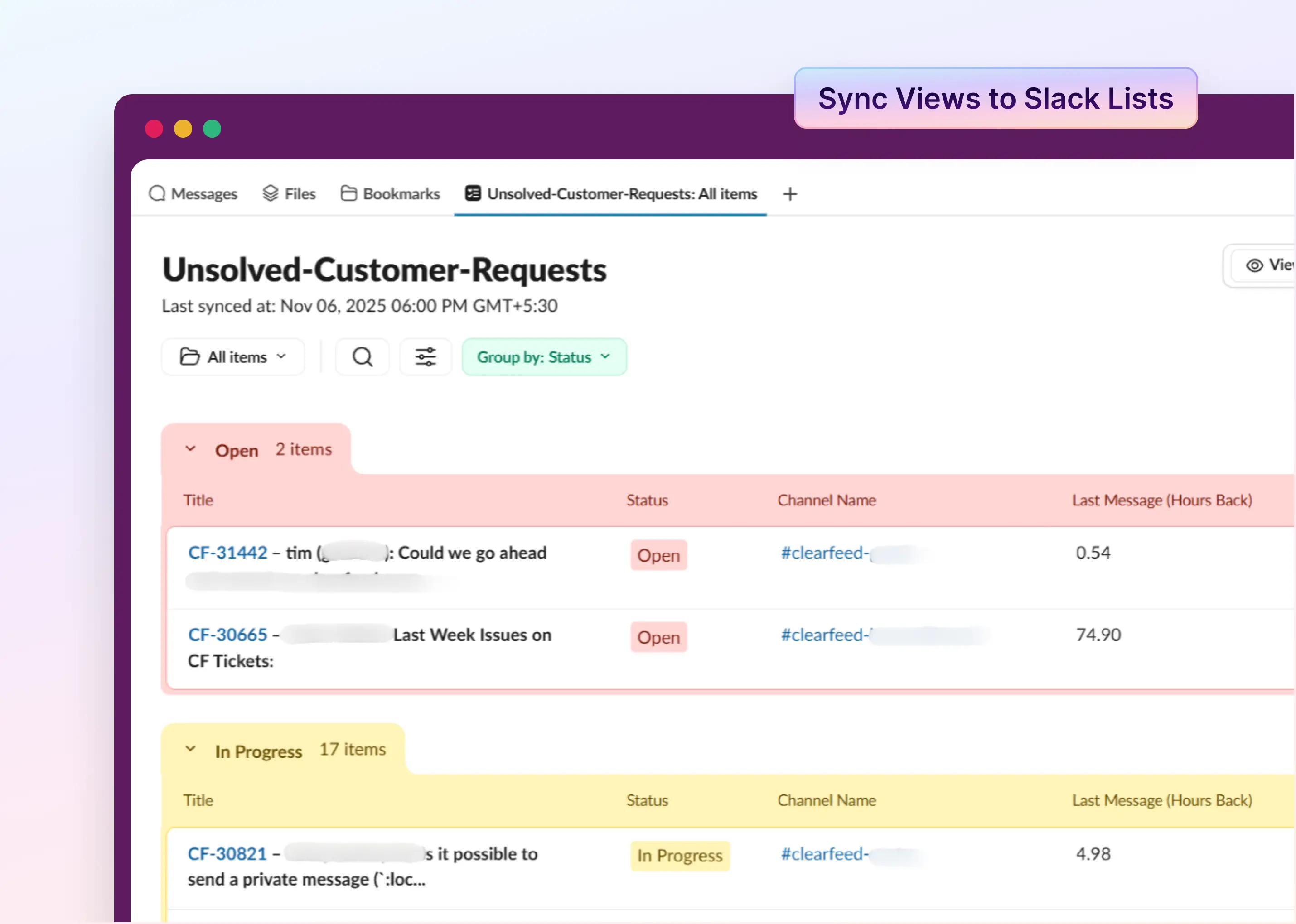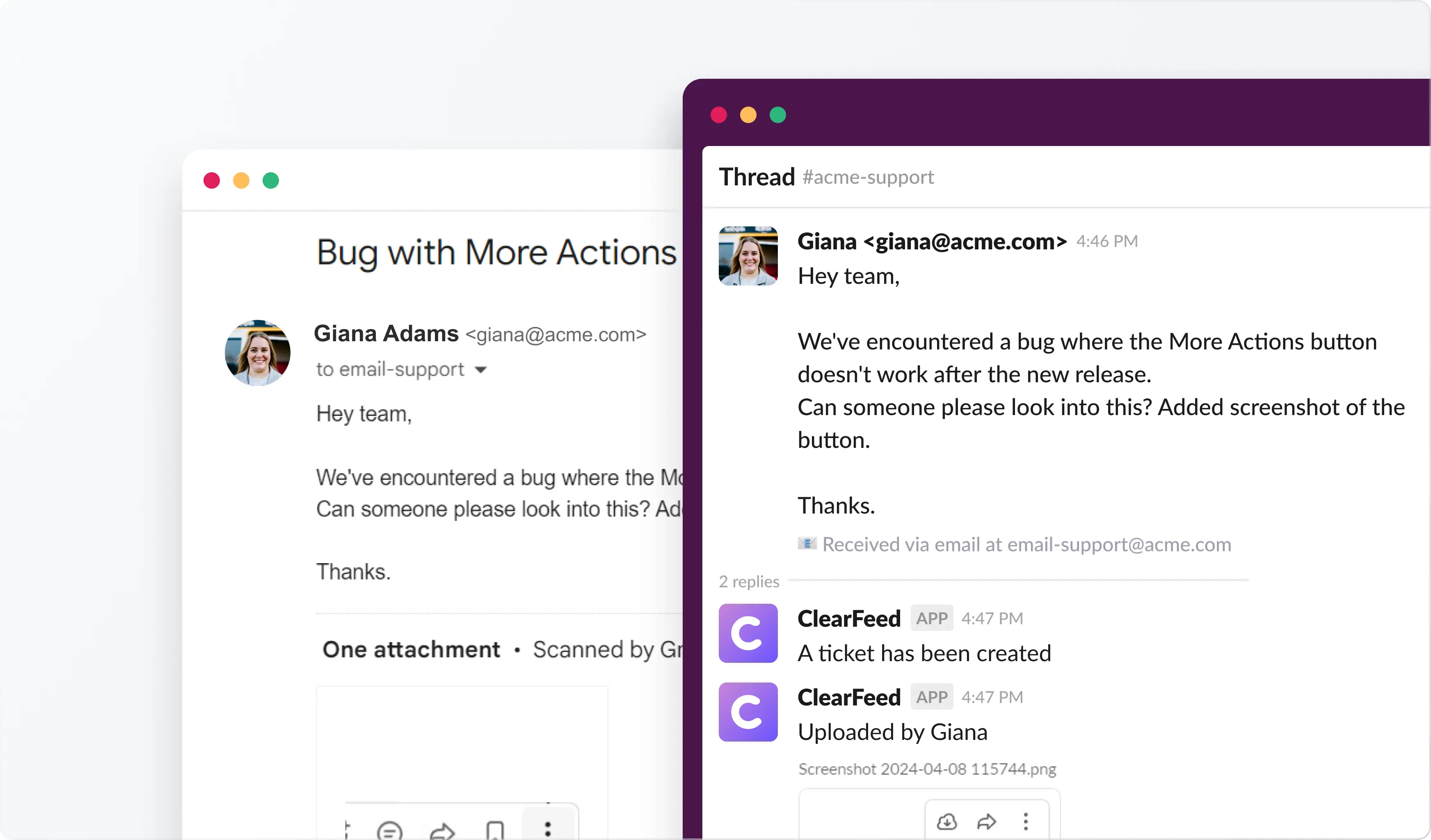If your support team relies heavily on Gmail, you've come across Hiver or are using it right now. Simple to set up and great for small, email-first teams, Hiver is often the go-to choice for getting started with customer support.
But as your team grows, support expands beyond email. Conversations move to Slack and chat. Expectations rise. And suddenly, Hiver starts to feel limited. Over time, growing teams have reported common challenges:
- Being tied into Gmail, with no support for Slack or chat
- Limited collaboration, automation, and visibility
- Friction when handling high ticket volumes or Slack-heavy workflows
- No built-in live chat, knowledge base, or AI-ready features
If any of this sounds like your situation, you're not alone, and you're certainly not stuck.
In 2025, B2B support teams require tools that are fast, work across multiple channels, and minimize the need for tab switching. That’s why we’ve put together this list of the top 10 Hiver alternatives, comparing features, integrations, and pricing to help you find the right fit.
10 Best Hiver Alternatives for 2025
The tools we've listed are trusted by support teams to reduce back-and-forth, enhance visibility, and improve efficiency, especially if your team frequently uses Slack. Each one offers similar features to Hiver, but the best choice depends on your team’s size and support setup.
For example, smaller teams prefer tools like Help Scout or Front for a simple, email-focused upgrade. Fast-scaling or Slack-first teams should consider ClearFeed, which offers advanced automation and real-time collaboration.
Here’s a closer look at the top Hiver alternatives, with a focus on shared inboxes, automation, and Slack integrations:
Let’s take a closer look at each platform’s features to understand what sets them apart.
1. ClearFeed

If your support operations are housed within Slack or MS Teams, ClearFeed is purpose-built for you. While Hiver locks you into Gmail, ClearFeed brings a fully functional shared inbox experience directly into your Slack. You can manage conversations, convert threads into tickets, automate triage with AI, and sync everything with your helpdesk or task management platforms.
Best for: Support teams that rely heavily on Slack to handle high ticket volumes, and want to manage both email and chat support in one place.
Key Features:
- Slack-First Ticketing: Convert Slack threads into tickets and manage the entire lifecycle (assign, update, escalate, or close) without switching tabs.
- Unified Inbox for Slack + Email: Manage emails (e.g., support@yourcompany.com) directly inside Slack connect channels. Agents can respond, assign, or resolve emails just like regular Slack threads.
- Bi-directional Email Sync: Customer emails are synced into Slack in real-time; agent replies from Slack are delivered via email, formatted correctly, and from the correct identity.
- AI-Powered Workflows: Built-in GPT features suggest replies, summarize conversations, detect unanswered queries, and fill ticket fields automatically.
- SLA Monitoring: Monitor ownership, first response times, and SLA breaches right inside Slack, complete with automatic alerts and reminders.
- Smart Routing & Assignment: AI auto-classifies and routes tickets based on message content. Use emoji actions or commands to assign and tag.
- Broad Integrations: ClearFeed works both standalone and alongside your existing platforms, integrating with Jira, Zendesk, Intercom, Linear, and more. Keep Slack in sync with your help desk and task management tools, such as Asana and ClickUp.
- In-Slack Collaboration: Use @mentions, private notes, and emoji-based triage to manage assignments and escalate issues without cluttering the main conversation.
Discover how to integrate your Slack with email for a more efficient workflow, or explore our comprehensive documentation on Slack-Email integration.
2. Tidio

Tidio is a flexible customer support platform that brings together a shared inbox, email integration, live chat, and AI-powered chatbots. It supports multiple channels and offers real-time engagement and automation, making it ideal for e-commerce and small support teams.
With its free-forever plan and easy setup, it’s a cost-effective option. However, if your team relies heavily on Slack, Tidio may not be the best fit for you.
Best for: Small to mid-sized support teams (e-commerce, SaaS, service providers) looking to manage email, web chat, and social channels in one place, with basic AI functions.
Key Features:
- Unified Shared Inbox: View and manage all messages from email, live chat, Facebook Messenger, Instagram, and WhatsApp in one place.
- Email Integration & Helpdesk: Connect Gmail and other mailboxes; emails convert to tickets and can be assigned, tagged, and tracked like chat conversations.
- Live Chat & Chatbots (Lyro AI): Deploy chatbots that can answer up to 70% of questions via AI flows and escalate complex ones to human agents.
- Internal Collaboration: Utilize internal notes, shared tags, and message assignments to maintain team alignment.
- Automation & Flows: Automate tasks like canned responses, ticket routing, tagging, and proactive chat using visual flow builders.
- Visitor Insights: Monitor live visitor activity (e.g., pages viewed, cart items) and trigger personalized messages based on behavior.
3. Zendesk

Zendesk is a powerful, enterprise-grade customer support platform built for scale. While it may be more than what smaller teams need, it’s a top-tier choice for fast-growing or large organizations that need structured workflows, deep reporting, and multichannel support far beyond what Hiver can offer.
Best for: Large, structured support teams handling high ticket volumes across multiple channels.
Key Features:
- Shared Inbox + Ticketing: Centralized system for managing customer conversations from email and other channels, organized by status, priority, and ownership.
- Multichannel Support: Handle customer queries via email, live chat, voice, social media (Facebook, Twitter), and messaging apps (WhatsApp, Messenger), all in one place.
- Automated Workflows: Use powerful rule-based automation to assign, tag, escalate, and follow up on tickets, ideal for SLA-driven environments.
- AI-Powered Tools: Zendesk AI assists with drafting responses, prioritizing tickets, and deflecting repetitive queries via Answer Bot and macros.
- Skills-Based Routing: Ensure customer tickets are routed to the right agent based on expertise and availability for quicker resolutions.
- Macros for Quick Replies: Utilize pre-written templates to respond more quickly and maintain a consistent messaging style.
4. Freshdesk

Freshdesk, by Freshworks, is a robust yet user-friendly customer support platform that combines shared inbox functionality with omnichannel ticketing, smart automation, and AI-powered features. If your team has outgrown Hiver's basic Gmail-based setup, Freshdesk offers a scalable and affordable step up without the steep complexity of tools like Zendesk.
Best for: Growing support teams that want a full-featured helpdesk without the enterprise-level learning curve or price tag.
Key Features:
- Shared Inbox with Ticketing: Convert emails into trackable tickets and manage them across team inboxes with clear ownership and visibility.
- Collision Detection & Assignments: See who's working on what in real-time to prevent duplicate replies; use smart auto-assignment rules to distribute workload.
- Freddy AI: Automate triage, draft reply suggestions, summarize conversations, and streamline tasks with AI assistance.
- Omnichannel Support: Handle queries across email, chat, phone, WhatsApp, and Facebook on a single dashboard.
- Workflow Automation & SLAs: Automatically tag, route, and escalate tickets according to predefined rules. Set SLAs to manage deadlines and response expectations.
- Parent-Child Ticketing: Break down complex issues into sub-tickets that multiple teams can work on in parallel.
5. Zoho Desk

Zoho Desk is a scalable, email-centric helpdesk solution that builds upon what Hiver offers without straying too far from what support teams are accustomed to. It provides powerful ticketing, automation, and AI features while keeping email at the core, which makes it a natural upgrade for support teams that want structure without complexity.
Best suited for: Support teams using Zoho tools or those seeking a cost-effective, structured, and email-first helpdesk solution.
Key Features:
- Email-to-Ticket Conversion: Automatically converts incoming emails into trackable tickets with IDs, assignments, and priority.
- Shared Inbox with Collaboration: Collision detection, internal notes, and ticket ownership ensure smooth teamwork and zero duplication.
- AI-Powered Assistance (Zia): Zia, Zoho's built-in AI, helps agents by drafting replies, tagging tickets, analyzing sentiment, and recommending help articles.
- Workflow Automation & SLAs: Set up rules for routing, escalations, and time-based SLAs to stay efficient and accountable.
- Contextual Integrations: Native integrations with Zoho CRM, Zoho Mail, Google Workspace, Slack (notifications), Jira, and more.
- Work Modes: Organize tickets based on priority, due date, or status. This helps agents quickly focus on the most critical tasks first.
6. Help Scout

Help Scout is a customer support platform designed for growing teams that prioritize simplicity, email-first workflows, and human-centric support. It combines a shared inbox with live chat, CRM-style customer views, automation, and a self-service knowledge base, all without the complexity of traditional help desks.
If you're looking for a clean upgrade from Hiver that still feels personal and easy to use, Help Scout is a great fit.
Best for: SMBs in SaaS, eCommerce, or nonprofits that rely on email/chat support and value ease of use and customer relationships.
Key Features:
- Shared Inboxes with Collision Detection: Handle incoming messages as a team while avoiding duplicate replies; agents see when someone is already working on a thread.
- Internal Collaboration: Utilize private notes and @mentions to maintain contextual and internal communication.
- Live Chat (Beacon): Embed live chat and knowledge base articles on your site to assist customers proactively.
- AI Assistance (Built-in): Draft replies, summarize threads, and answer questions using integrated AI, available on all plans.
- Workflow Automation: Route emails, tag conversations, and set rules using simple no-code flows.
- Saved Replies: Speed up responses with reusable canned messages and help doc links.
7. Front

Front is a great Hiver alternative if you want to reply from your work email (e.g., jane@yourcompany.com) while still utilizing shared inbox features. It pulls in messages from email, SMS, chat, and social media all into one inbox, so your team doesn't have to jump between tools.
It’s more flexible than Hiver and works well if your team handles a lot of support across different channels and wants to maintain a personal touch for customers.
Best for: Support and success teams that want multichannel visibility, structured collaboration, and a more personal approach to communication.
Key Features:
- Internal Collaboration: Collaborate with teammates using shared drafts, comments, @mentions, and internal notes directly within the message thread.
- Assignments & Collision Detection: Assign tickets, see who’s viewing or replying, and prevent duplicate responses.
- Smart Workflows & Automation: Route messages, auto-assign using round-robin, tag conversations, and set SLA alerts using custom rules.
- Thread Merging: Automatically combine related conversations across channels for a more complete support view.
- Customer Context: View full message history and customer data alongside every conversation to reply faster and more personally.
- Robust Integrations: Connect with 100+ tools like Slack, Salesforce, Twilio, Jira, and more. Open API available for custom workflows.
8. LiveAgent

LiveAgent is a feature-rich, all-in-one helpdesk platform designed for teams managing high volumes of customer interactions across multiple channels, including email, chat, voice, and social media. It’s a powerful Hiver alternative for teams that need multichannel support without the cost or complexity of enterprise tools like Zendesk.
Best for: Support teams that need a shared inbox, live chat, and voice support at an affordable price.
Key Features:
- Email Ticketing System: Convert incoming emails into tickets, assign them to agents, and track their progress with ease.
- Hybrid Ticket Streams: Maintain a unified conversation history, even when a chat transitions into an email or a call is escalated into a ticket.
- AI Chatbot Assistant: Handle up to 75% of common chats automatically before escalating to live agents.
- Live Chat Widget: Add a customizable, real-time chat feature to your website, complete with features like proactive triggers and typing indicators.
- Built-in CRM: Access customer profiles, past conversations, and contact history directly within your helpdesk.
- Call Center Features: Includes IVR, call transfers, call recording, and callback options, fully integrated into the system.
9. HubSpot Service Hub

HubSpot is one of the best free alternatives to Hiver if your team needs more than just email support. It offers a shared inbox, live chat, social messaging, ticketing, and service tools, all in one place.
It’s a natural upgrade from Hiver, especially for teams already using HubSpot’s CRM or looking to unify support and marketing efforts without added complexity or cost.
Best for: Customer success, marketing, and support teams that want shared inboxes, ticketing, and support tied closely to CRM data.
Key Features:
- Shared Team Inbox: Connect addresses like support@ or info@ and manage conversations with ownership assignments, filters, and internal comments to keep things organized.
- Integrated Ticketing: Convert conversations into tickets with pipeline stages, priorities, and SLA rules for structured follow-up.
- CRM Context in Every Thread: See complete customer profiles, contact history, deals, and notes alongside every message for better personalization.
- Automation & Bots: Build workflows for ticket routing, assignments, and follow-ups. Use chatbots for FAQs or lead capture.
- Inbox-Level Reporting: Track key metrics, including average response time, open rate, resolution rate, and ticket status, directly from email-based support activities.
- Gmail & Outlook Integration: Agents can send and receive emails from their inboxes (e.g., Gmail) while still tracking conversations inside HubSpot's shared inbox and CRM.
10. Missive

Missive offers a more flexible, team-friendly experience than Hiver. It combines the familiarity of Gmail and Outlook with shared inboxes, real-time chat, task management, and multi-channel support, all within a single, clean interface. For teams that want better visibility and teamwork without the complexity of a traditional helpdesk, Missive is a smart, lightweight upgrade.
Best for: SMBs using Gmail or Outlook that want chat-style collaboration and Kanban-style visibility without switching to a full-scale helpdesk.
Key Features:
- Chat-Style Email Threads: Turn every email into a real-time conversation with internal chat and comments.
- Collaborative Drafting: Co-edit replies, leave internal notes, or review messages together before sending.
- Kanban Views: Organize conversations visually using Kanban boards (e.g., New, In Progress, Waiting) to track status at a glance.
- Two-Way Email Sync: Works natively with Gmail, Outlook, Office 365, or IMAP, keeping your email fully in sync without forwarding.
- Built-In AI Tools: Use ChatGPT-powered features to draft, translate, or edit messages right inside your inbox.
Final Thoughts
Hiver made managing shared inboxes easy, but as support needs grow, handling Slack threads, escalations, and SLAs reveals its limitations. You could add more tools to fill the gaps, but that would only add complexity and cost. The innovative approach would be to choose a support platform that scales with your team's needs, both now and as you grow.
Most of the Hiver alternatives we've reviewed offer free trials or starter plans, allowing you to test them before committing to a paid plan. If you're still email-first and need advanced features, tools like Help Scout or Freshdesk might be a good fit. But if your team is Slack-first and thrives on real-time collaboration, ClearFeed is the solution for you. It helps you stay organized, respond more quickly, and minimize the need to switch between tools frequently.
See how ClearFeed compares to Hiver – start your 14-day free trial or book a demo to see it in action!

















